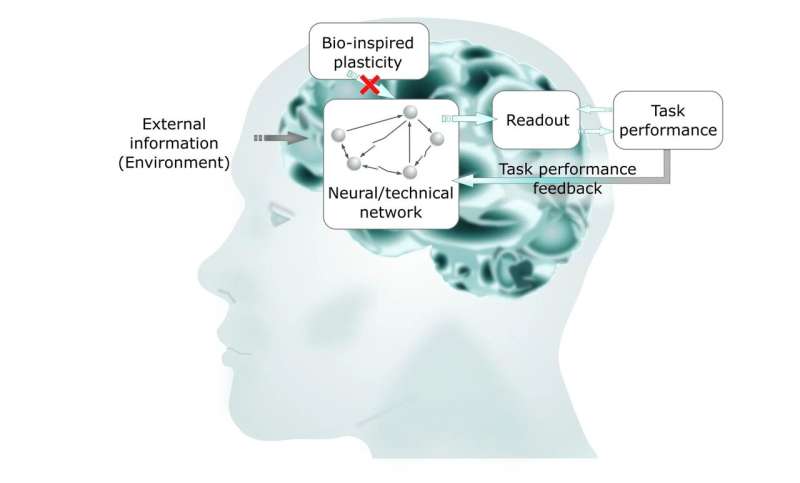Examining the optimal working conditions for the brain as a model for new computers

With mathematical modeling, a research team has now succeeded in better understanding how the optimal working state of the human brain, called criticality, is achieved. Their results mean an important step toward biologically-inspired information processing and new, highly efficient computer technologies and have been published in Scientific Reports.
“In particular tasks, supercomputers are better than humans, for example in the field of artificial intelligence. But they can’t manage the variety of tasks in everyday life—driving a car first, then making music and telling a story at a get-together in the evening,” explains Hermann Kohlstedt, professor of nanoelectronics. Moreover, today’s computers and smartphones still consume an enormous amount of energy.
“These are no sustainable technologies—while our brain consumes just 25 watts in everyday life,” Kohlstedt continues. The aim of their interdisciplinary research network, “Neurotronics: Bio-inspired Information Pathways,” is therefore to develop new electronic components for more energy-efficient computer architectures. For this purpose, the alliance of engineering, life and natural sciences investigates how the human brain is working and how that has developed.
Close to chaos: The greatest performance is possible here
Information processing in the brain is based on a network of around 86 billion neurons. They pass on information in the form of voltage pulses via synapses and axons—either simultaneously or independently of one another (“synchronization”).
According to a thesis from neurobiology (“the critical brain hypothesis”), our brain processes information the most quickly and energy-efficiently when it is in the “phase transition” in between. This intermediate state, the so-called “criticality,” can also be detected using magnetic resonance imaging (MRI) or electroencephalography (EEG).
In this highly complex state, the brain can react particularly sensitively and in a variety of ways to external influences, which is why it always tries to achieve this state. “The brain is close to the chaos here: Even small external stimuli suddenly cause entire ensembles of neurons to fire. Information spreads like an avalanche and can therefore be transmitted particularly easily, even to areas of the brain that are far apart,” explains Kohlstedt. This enables a wide range of reactions.

Simulated in an artificial network
In their current publication, the scientists at CAU investigated how this state of criticality emerges in neuronal and also artificial networks. Until now, it was assumed that it is a “self-organized criticality” for which mechanisms in the brain alone are responsible. “However, we were able to show for the first time that external influences, i.e. the environment itself, also lead to this state to be ‘imposed’ on brain-like networks,” says first author Dr. Petro Feketa, a member of CRC 1461 and the Chair of Automation and Control Engineering at CAU.
To do this, the team applied mathematical modeling in an artificial network of nonlinear oscillators. Similar to neurons in a neural network, these circuits generate periodic voltage pulses that can also synchronize. In addition, the connections between oscillators can change. The research team simulated how the oscillators connect over time as they interact with the environment in order to solve tasks as quickly and efficiently as possible.
The network repeatedly achieved a state of criticality, similar to that in the brain. “This was particularly surprising because the criticality property was not present initially and we did not aim for achieving this originally,” Feketa said.
Evolutionary biology: Wide range of reactions makes sense
“From the point of view of evolutionary biology, this result is quite understandable. Our environment is so diverse that the structure and internal dynamics of our brain have been shaped in such a way that the state of criticality provides a maximum range of solutions for a wide variety of tasks,” says Prof. Dr. Thomas Meurer, head of the Chair of Automation and Control Engineering at CAU.
The brain has therefore adapted its state of criticality to influences and the increasing demands of the ever-changing environment. “To put it simply, one could say: our brain grows with its tasks—even more than we had previously thought,” says Kohlstedt.
Petro Feketa et al, Structural plasticity driven by task performance leads to criticality signatures in neuromorphic oscillator networks, Scientific Reports (2022). DOI: 10.1038/s41598-022-19386-z
Citation:
Examining the optimal working conditions for the brain as a model for new computers (2022, November 4)
retrieved 4 November 2022
from https://techxplore.com/news/2022-11-optimal-conditions-brain.html
This document is subject to copyright. Apart from any fair dealing for the purpose of private study or research, no
part may be reproduced without the written permission. The content is provided for information purposes only.
For all the latest Technology News Click Here
For the latest news and updates, follow us on Google News.
